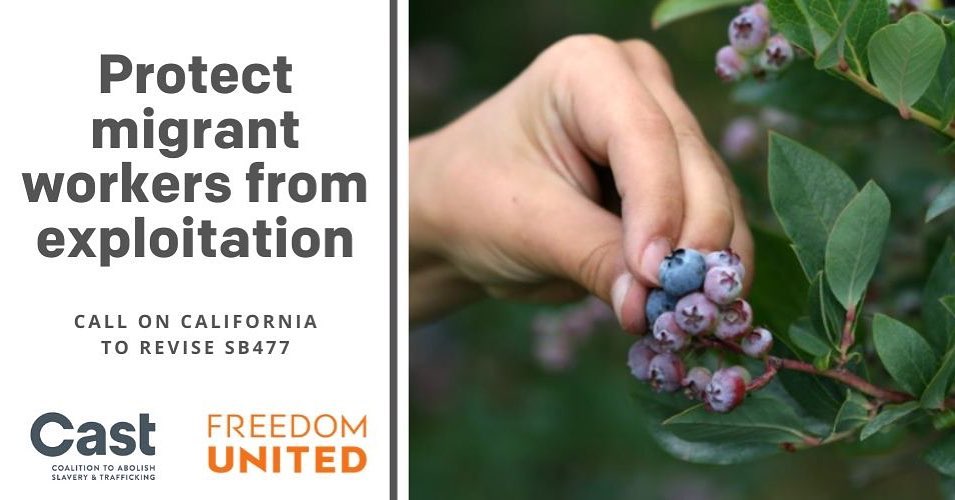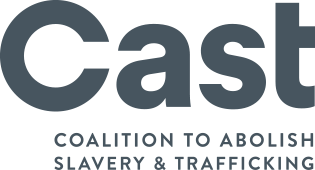
Call on California to revise SB477
Thousands of temporary workers are being trafficked into forced labor in California under threat of violence, deportation, and harm to their families.
California attracts more temporary foreign workers than anywhere else in the US. As the fifth largest global economy, workers on lawful visas from all over the world seek opportunities in California.1
The vast majority of temporary workers are recruited via third-party foreign labor contractors (FLCs), some of whom act neither lawfully nor ethically.
For example, unscrupulous FLCs have been known to drive to remote Mexican villages to find their recruits, who they contact via Facebook and WhatsApp. The FLCs take advantage of the desperation of low-income workers in these villages to increase their profits by charging high fees and deceiving them into exploitative work conditions.2
Once in the US, workers are bound to a single employer and are dependent on them for housing, food, and visas. Employers can take advantage of this power imbalance to abuse their workers—and because FLCs act as brokers between employer and worker, employers bear little responsibility for any wrongdoing.
These circumstances mean that temporary workers are among the most exploited legally authorized workers in the country. The full scope of the problem is not known because workers rarely report labor abuses for fear of losing their jobs and immigration status.
California state legislators tried to address these risks in 2014 by passing Senate Bill 4773(SB477), a bill designed to create better oversight for FLCs, with wide bipartisan support. The bill aimed to regulate FLCs by requiring:
- The registration of FLCs
- The use of only registered FLCs by California employers
- Full and honest disclosure of working terms and conditions during the recruiting process, including no fees, and
- Penalties for failure to comply with these requirements
The bill became law in 2016. However, because of an error in the way this new law was incorporated into existing legal provisions for farmworkers, it fails in its goals. As it’s currently framed, the new legislation allows for an interpretation that would limit the law to non-agricultural workers on H-2B visas. With the vast majority of migrant workers in California being on other temporary work visas, only around 3% of migrant workers are protected by SB477.
As currently interpreted, SB477 leaves thousands of temporary workers in California at high risk of exploitation and human trafficking.4
This must change.
Since noticing the error, our partners at the Coalition Against Slavery and Trafficking have been lobbying for the small legislative change needed to fix the law. While simple, the amendment has faced opposition from industry lobbyists who stand to gain from the loophole.5
We are calling on the California State Legislature to support the amendment to fix SB477 to support all FLC visa workers by:
- Fulfilling SB477’s original goal of covering all migrant workers by deleting Section 9998 of California Business and Professions Code. This section, which you can read below, creates the loophole which allows workers on H-2A visas to fall through the cracks. This chapter shall apply only to “nonagricultural workers” as defined by Section 1101(a)(15)(H)(ii)(b) of Title 8 of the federal Immigration and Nationality Act. It shall not apply to any person duly licensed as a “farm labor contractor” as that term is defined in Section 1682 of the Labor Code nor shall it apply to any person exempt from the licensing requirement in Section 1682.5 of the Labor Code or to any employer employing agricultural workers as defined by Section 1101(a)(15)(H)(ii)(a) of Title 8 of the federal Immigration and Nationality Act
- Adding text that would be holding both foreign labor contractors and employers who use their services responsible for fulfilling the requirements of SB477 by replacing Section 9998.8(d) of the Business and Professions Code with the following text. Foreign labor contractors and those persons using their services to obtain foreign workers or employees are jointly and severally liable for violations of this chapter.
- Defining anyone who knowingly benefits from violations of California’s labor trafficking laws as a human trafficker, and bringing them to justice either by fine or imprisonment by adding the following text to the California Penal Code. A person who deprives or violates the personal liberty of another with the intent to obtain forced labor or services, or who knowingly benefits, financially or by receiving anything of value from such a deprivation or violation, knowing or in reckless disregard of that deprivation or violation, is guilty of human trafficking and shall be punished by imprisonment in the state prison for 5, 8, or 12 years and a fine of not more than five hundred thousand dollars ($500,000).
20 years ago- The U.S. Congress passed the Trafficking Victims Protection Act of 2000, the first federal law combatting human trafficking in the U.S. and globally.
15 years ago- California passed its first law, AB 22 (Lieber), to combat human trafficking state-wide.
10 years ago- Mayor, now Governor, Newsom started a human trafficking task force in San Francisco, California, with other cities and counties across the state following his lead.
THE TIME TO ACT IS NOW:
Call on the California State Legislature to amend Senate Bill 477 to protect all migrant workers, regardless of visa or industry, from forced labor and human trafficking.
Notes:
- https://www.usatoday.com/story/news/nation-now/2018/05/05/california-now-worlds-5th-largest-economy-beating-out-uk/583508002/ ↩
- https://civileats.com/2019/07/16/the-h-2a-guest-worker-program-has-ballooned-in-size-but-both-farmers-and-workers-want-it-fixed/ ↩
- http://leginfo.legislature.ca.gov/faces/billNavClient.xhtml?bill_id=201320140SB477 ↩
- https://civileats.com/2019/07/16/the-h-2a-guest-worker-program-has-ballooned-in-size-but-both-farmers-and-workers-want-it-fixed/ ↩
- https://www.castla.org/wp-content/uploads/2019/11/2020-Advocacy-Agendafinal.pdf ↩

